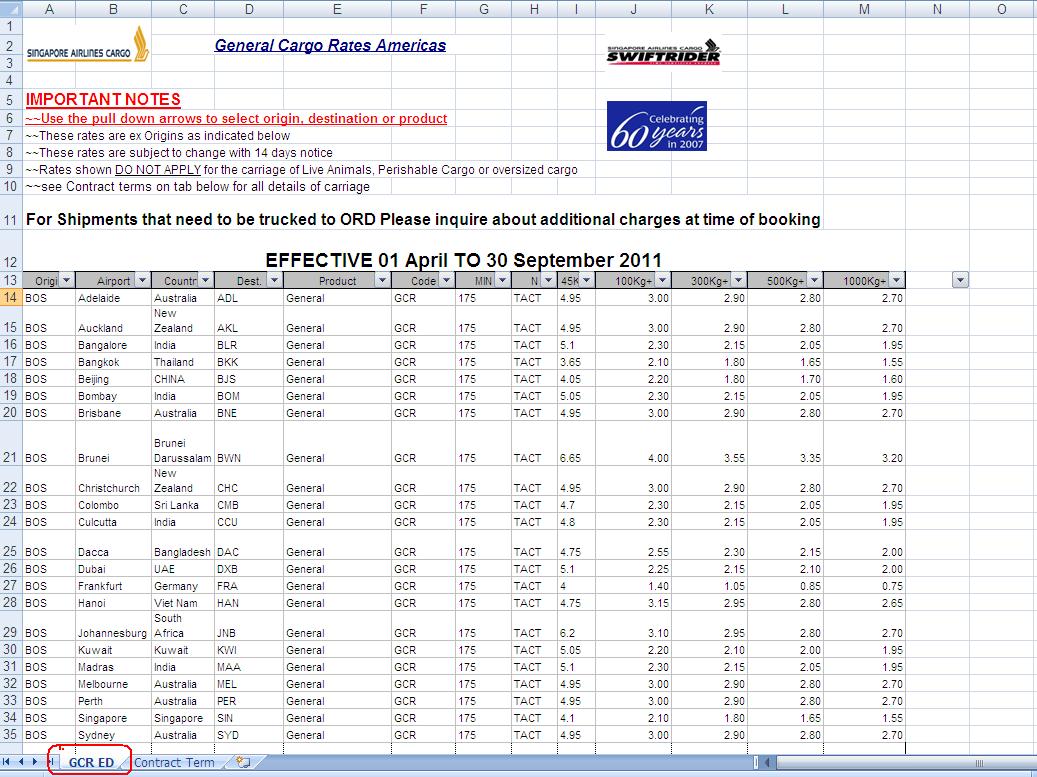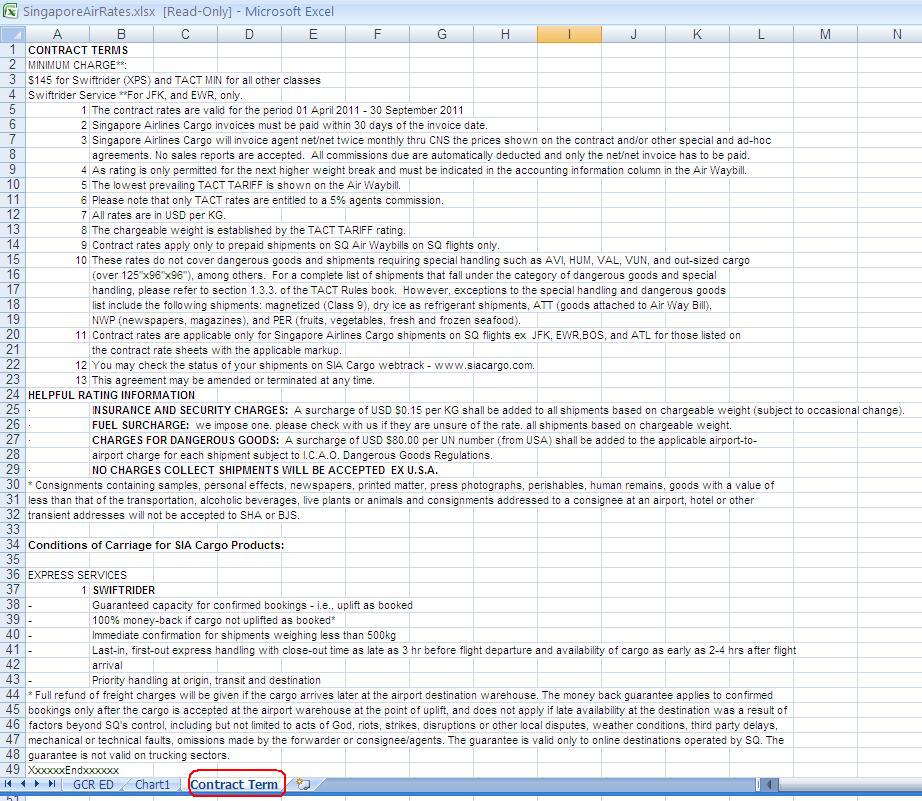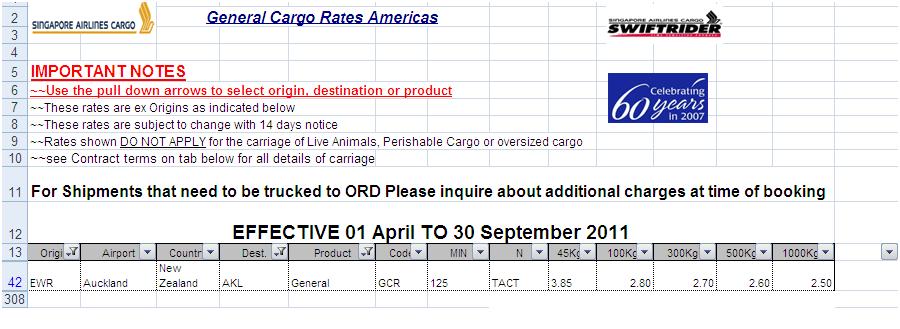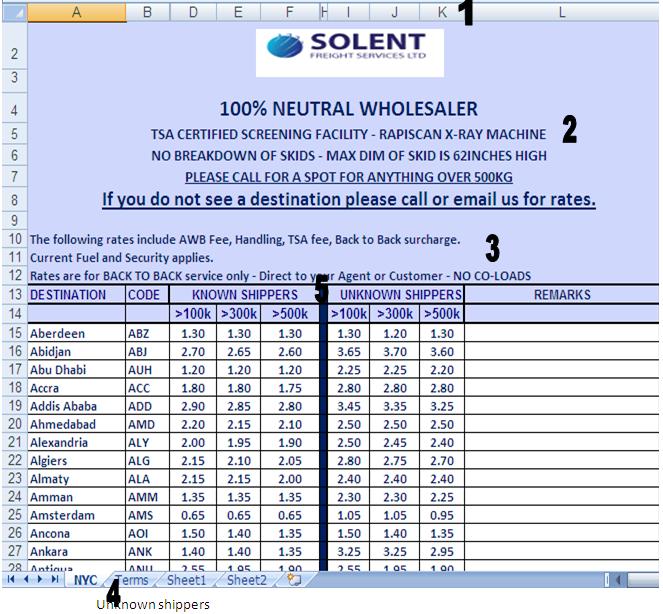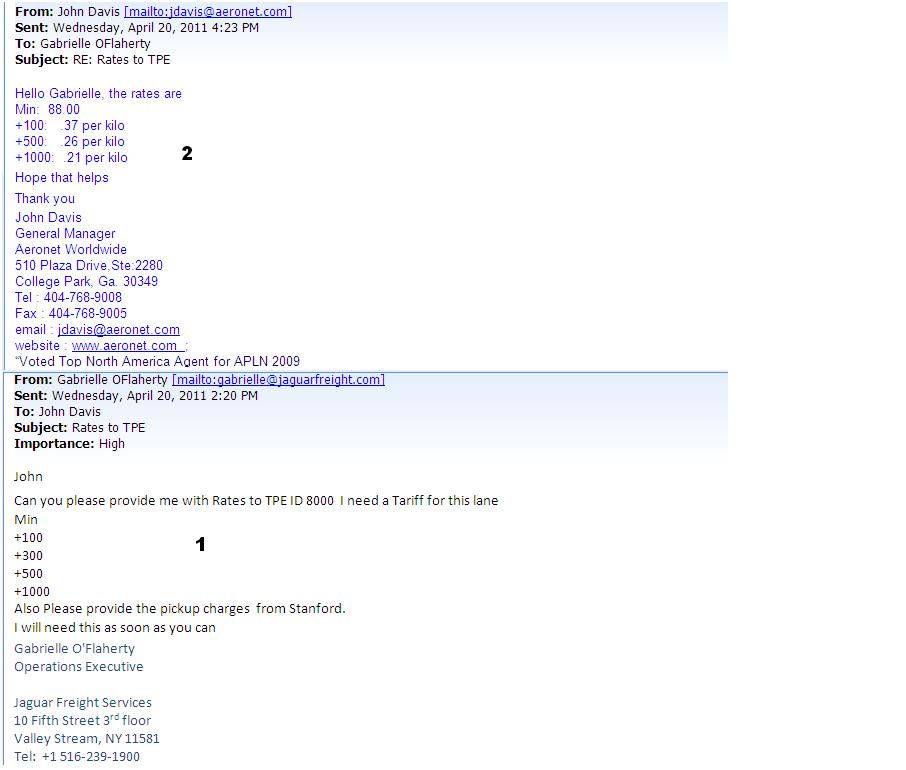Rates DB Air (Requirements)
From UG
(→Singapore Air contract) |
(→Solent co-loader tariff) |
||
| Line 252: | Line 252: | ||
**k. The rate per K for 300-599 for Unknown shippers | **k. The rate per K for 300-599 for Unknown shippers | ||
| + | ===== Email exchange for rates ===== | ||
| + | |||
| + | |||
| + | [[File:Email Exchange example.JPG]] | ||
| + | |||
| + | *1- The bottom portion of the email, you will see that Gabrielle (NY Export Operator) is requesting an air tariff from Aeronet (Co-Loader). | ||
| + | **a. You will see that she indicates she needs the rate going to TPE (this is the airlines code for Taipei). | ||
| + | **b. She also indicates that this is ID8000. This is because she is looking for a rate for cosmetics. Cosmetics can be considered Hazardous, but this commodity does not need a hazardous UN number. She is advising the co-loader that the freight is ID8000 because some airlines will charge a hazardous fee for this and some will waive the hazardous fee. | ||
| + | *2- This is the reply – the rate tariff for this specific, lane and commodity. | ||
===== Misc ===== | ===== Misc ===== | ||
Revision as of 14:01, 26 April 2011
Info
- mantis# 0002894: [Rates DB] Implement phase1 for MOT Air
See also: http://ct.jaguarfreight.com/wiki/Rates_DB
Glossary
Weight Break is the point at which the weight or chargeable weight of a shipment is large enough to be assessed the lower freight rates which are applicable to larger shipments, this is as per the carrier's tariff.
Chargeable Weight of cargo intended for air shipment is the actual gross weight (gw) or the volume weight (vw), whichever is greater.
Actual Gross Weight or GW is the actual weight of the shipment
Volume Weight or VW is calculated based on a cargo's size, measurement or dimensions
Minimum or Min is the lowest amount that can be charged for the service.
Maximum or Max is the highest amount that can be charged for the service.
Flat Fee is a single fixed fee for a service
Unit load device or ULD is a pallet or container used to load freight on an aircraft. It allows a large quantity of cargo to be bundled into a single unit.
- ULD pallets are rugged sheets of aluminum with rims designed to lock onto cargo net lugs
- ULD containers, also known as cans and pods, are closed containers, which, depending on the nature of the goods to be transported, may have built-in refrigeration units
Drum is a cylindrical container used for shipping bulk cargo (a liquid or as a mass of relatively small solids like grains). Drums can be made of steel, dense paperboard (commonly called a fiber drum), or plastics, and are generally used for the transportation of certain dangerous materials or modest quantities of bulk goods.
Known Shipper A shipper that is qualified by specific regulations as a known shipper. A known shipper has less restrictions for shipping and as a result will usually have lower rates.
Unknown Shipper A shipper that has not yet been qualified according to the Transportation Security Administrations regulations as a known shipper. An Unknown shipper's cargo has more restrictions when shipping and therefore may have to pay higher rates to ship cargo.
Hazardous Freight is freight that is capable of posing risk to people, health, property, or environment when transported in quantity. AKA dangerous goods
Summary
What are we trying to achieve? What are the main goals of this module?
Core need
See Rates DB.
Core functionality
See Rates DB.
Q and A
Charge codes and other CT2 components related to Rates DB Air
Question
- Please explain what do we already have in CT2 that is related to Rates DB.
- Explain the meaning of each charge code and how they are related.
Answer
File below is cc air.xls attached to 0002894: [Rates DB] Implement phase1 for MOT Air
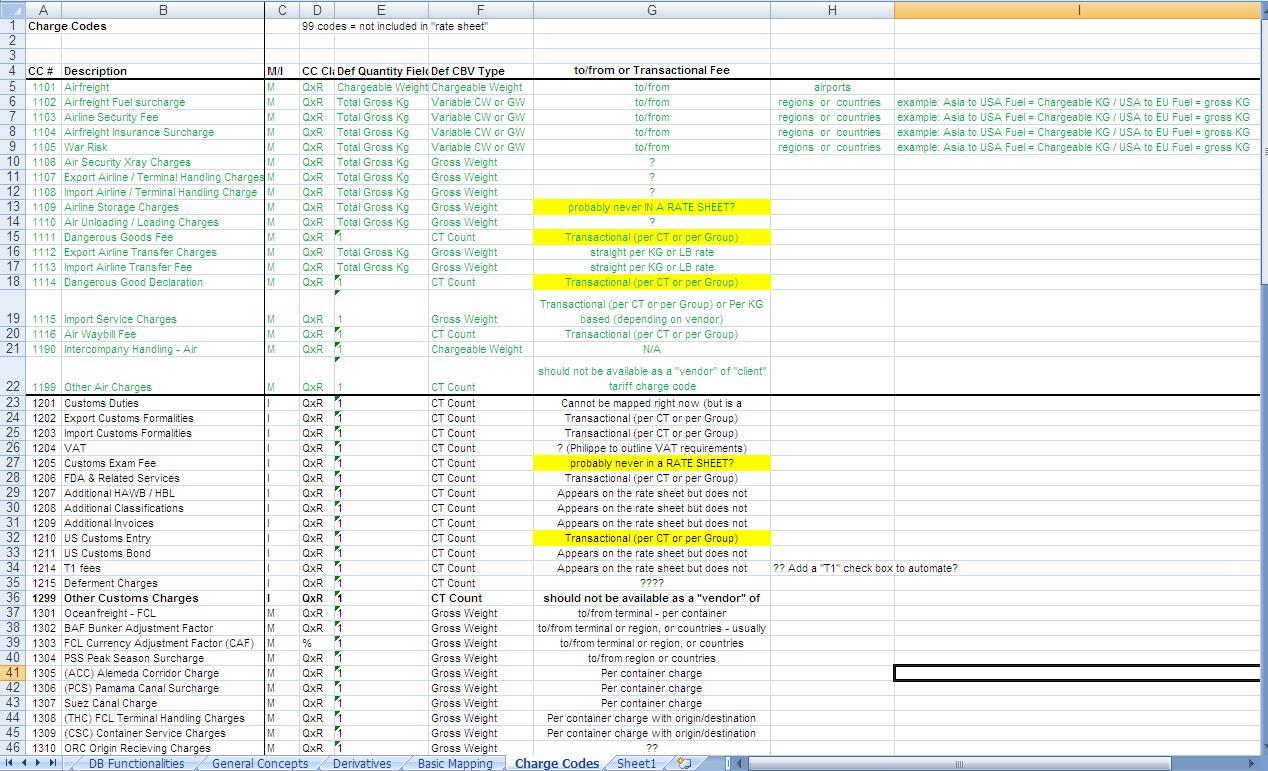
Current business process
Questions
- What ids the current business process - How Jaguar deals with Contracts and Tariffs (in each office) now?
- Who is in charge for this in each office?
- Please describe "A Day in the life of Inside Sales Dept NOW"
- In what form existing Air contracts received and maintained ?
- How requests for rates handled (receive, search, answer)?
- What is the typical Request format?
- What is typical Response format?
- Sounds like most of these are "spot rates" received by phone call? Is that right? Do we ever in a response to a phone call ever receive "entire contract" by email instead of just rate from A to B for specific cargo and dates?
Answers
Since Air freight shipments move quickly, when you are contacted for rates, you must provide the rates as quickly as possible. Also, Jaguar Freight does not handle a large volume of air freight shipments and are not currently IATA certified. These are a couple of the reasons, that we do not have many tariff's in place
NY office
NY office has a special group called "Inside Sales".
- Steve - manager
- Sylvia - handles mostly ocean, gets involved into ocean contracts, main user of Rate Explorer?
- Mary - handles ocean, air
They are responsible for providing cost's to our Outside Sales team, operations team, and overseas offices. In addition to obtaining costs for internal employees, they also quote out cost's the customers.
Currently, requests are usually received verbally (in person), via email, or via telephone. Once the request is received, the inside sales team will begin to research the cost. They begin by determining if the specifications of this shipment are covered within already existing airline tariffs. This is done by checking 1st that the airline has flight from and to the desired airports. Once this is confirmed, they still need to make sure that the airlines has the room required (over sized freight can only shipper on freighter not a passenger aircraft), accepts the specified commodity type (certain kinds of hazardous freight cannot ship on a passenger aircraft), and accepts freight from this shipper type (Unknown shippers cannot ship on a passenger aircraft).
If they find multiple airlines fitting these specifications, they will determine the best rate and service level. This is the information they will use to quote out the air portion of this rate.
If it does not, they will then research all of this information again using an existing co-loaders tariff. Once again, if multiple rates are found they will select one based on price and service comparison and use this to quote out the air portion of this rate.
If the shipment specifications are unusual, large, or are not covered under any existing tariff, they will email or call the airline or co-loader to find someone that can give them a cost. They will complete the total cost's of the shipment by calculating the rates for any additional services required. (pickup, delivery, Customs, etc...)
In addition to the inside sales team, operators, sales, and management are also involved in obtaining cost's.
Everyone seems to be handling the management of the rates that they obtain in their own way. Some keep them saved in their emails, some keep them saved on their desktop, and some have the rates printed out and keep paper copies.
....
NY office has tariffs in place with 4 airlines and 3 co-loaders. Steven the inside sales manager intends to increase this in the future.
London office
The London office has three main contacts for Cost/Sell rates.
Vikesh - Sales
Ginny - Account manager
Anshu - Inside Sales
The London office currently does not book freight directly with any airlines, they only book with co-loaders. They have no airline tariff's in place at this time. When they need to cost out an airfreight shipment, they will always handle this on a spot rate basis at this time. They are currently using two co-loaders Hook and LS Express. Every time they receive a request for rates, they call or email the co-loaders for a rate.
They do not have any air rates in place because they do not handle a high enough volume of air freight shipments.
Also, they are afraid that they will be locked into using these co-loaders for the additional services (delivery, Customs, special handling, etc....)
EXAMPLE OF THE TYPICAL EMAIL EXCHANGE FOR OBTAINING RATES TO BE ADDED.
Paris office
TBD
HK office
Right now the main contact for rates in Hong Kong is Canny.
The rates are being managed and maintained by a spreadsheet that was created by the Hong Kong office and is updated by the agents / Co-loaders.
Currently Jaguar Hong Kong does not book shipments directly with any airlines, so they do not have any airline tariffs.
They rates requests (spot rates) and handled mostly via email.
Future business process
Questions
- What is the vision for the biz proc in the future?
- A Day in the life of Inside Sales ONCE SYSTEM IS IN PLACE.
- Explain vision of every office.
- This should be formulated by person responsible for this area(like Steven in NY).
Answers
NY office
TBD
London office
TBD
Paris office
TBD
HK office
TBD
Various types of Contracts and Tariffs And How to calculate rate from point A to point B
Questions
- Provide examples of contracts/tariffs used by Jaguar.
- At least one example for each type.
- Provide example of how to manually calculate rate for specific request.
- Attach actual contract/tariff into mantis. Post screen shot into wiki and explain.
- If possible classify all types of existing Air tariffs.
Answers
Singapore Air contract
It comes as an xls file with two tabs. See below. (Original file Singapore Air NYC Rates Apr 1 - Sep 30 2011 example rate sheet.xlsx attached to 0002894: [Rates DB] Implement phase1 for MOT Air ).
The attached spreadsheet is an example of one of the airlines tariffs.
The top of the page shows you the airline, the commodity (general cargo), any exclusion or notes and the date range these rates are valid for.
Table:
Column A is the origin of the shipment.
Column B is the name of the destination.
Column C is the Country of destination.
Column D is the 3 letter destination airport code.
Column E is the commodity type line.
Column F is the 3 letter commodity type
Column G is the minimum air freight charge for the origin and destination pairing (column A and Column D)
Column H TBD - (The – 45 kilo rate. This is the rate per Kilo from 0 K to the next weight break, in this example it is + 45 Kilo’s.
So this rate is for 1 Kilo – 44 Kilo’s, as long as the total is higher than the minimum rate.
Column I - is the + 45 Kilo rate. This is the rate per Kilo over 45 K and under the next weight break (in this example the next weight break is 100 +, so this rate is for 45K – 99 Kilo’s, as long as the rate is higher than the minimum.
Column J – Is the + 100 Kilo rate – following the same rules as Column I.
Column K – Is the + 300 Kilo rate – following the same rules as Column I.
Column L – Is the + 500 Kilo rate – following the same rules as Column I.
Column M – Is the + 1000 Kilo rate – following the same rules as Column I.
Using this drop downs on the spreadsheet, you can set filters to view multiple selections or narrow it down to just one line.
Tab 2
Example 1:
(Setting column A to NYC and Column D to AKL for a shipment from NY to New Zealand)
If you have a shipment of boxes that is a total of 5 cartons, total 20 K, and total 45 K chargeable weight going from NY to New Zealand.
You would use the dropdown to set as much information as possible.
I set A to NYC, D to AKL, and E to general. This narrowed it down to one line where I can see my rate for this shipment.
To calculate my rate I take my total chargeable Kilo's (45) and check the tariff according to this weight break to find which rate would apply to this shipment ($3.85). Next I compare this total with the minimum ($125.00) and take the higher rate as my cost.
45 x 3.85 = $173.25 (which is higher then the minimum of $125.00, so $173.25 is my cost)
Solent co-loader tariff
- 1- This is the company name of the co loader
- 2- Indicates that you can call for shipments not covered in this tariff.
- 3- Indicates what is covered by this tariff and what charges will be additional. ( Ex. AWB fee is included – Fuel and Security is additional )
- 4- This is the bottom tab of the excel sheet, indicating that these rates cover shipment departing from NYC
- 5- Rates
- a. Destination Column – arrival City
- b. Code – Airport Code
- c. Column C is hidden
- d. The rate per K from 0-99 for Known shippers only
- e. The rate per K from 100-299 for Known shippers only
- f. The rate per K from 300-499 for Known shipper only
- g. Column G is hidden
- h. Column H is a space holder
- i. The rate per K for 0-99 K for Unknown shippers
- j. The rate per K for 100-299 for Unknown shippers
- k. The rate per K for 300-599 for Unknown shippers
Email exchange for rates
- 1- The bottom portion of the email, you will see that Gabrielle (NY Export Operator) is requesting an air tariff from Aeronet (Co-Loader).
- a. You will see that she indicates she needs the rate going to TPE (this is the airlines code for Taipei).
- b. She also indicates that this is ID8000. This is because she is looking for a rate for cosmetics. Cosmetics can be considered Hazardous, but this commodity does not need a hazardous UN number. She is advising the co-loader that the freight is ID8000 because some airlines will charge a hazardous fee for this and some will waive the hazardous fee.
- 2- This is the reply – the rate tariff for this specific, lane and commodity.
Misc
Types and Examples of Air contracts
Examples attached to Mantis http://ct.jaguarfreight.com/mantis/view.php?id=2894 . Sample XLS Quote form. This is what the ISales department uses to create quotes. Sample PDF Quote form. This is a copy of the quote generated from the above. Sample XLS Quote Report. Steven Inside Sales Manager has been assigning a quote number to each quote he creates and logging these into an excel sheet to keep track. Sample of Co-loaders tariff - This is an example of one of the tariffs inside sales uses to search rates offered by one of our co-loaders. Singapore Rates - This is an example of one of the airlines rate tariffs used by inside sales to search rates offered by an airline.
Tariff management systems in use
Q
Please find and describe in details any tariff management systems that:
- a) Jaguar is using
- b) know but not used in Jaguar
